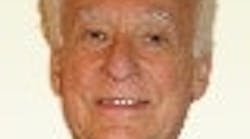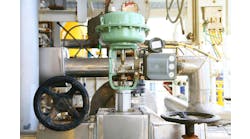IN 1974, I was a 38-year-old chief instrument engineer at Crawford and Russell (today John Brown) when Sam Russell, the president/owner of C&R, received a telephone call from the U.S. Dept. of Energy (DOE). Sam was a "can do" American totally unafraid of challenges.
During World War II, he worked on FDR's task force which, when the Japanese cut off our natural rubber supplies, developed a synthetic rubber industry from scratch. Within a couple of years, Sam and his team moved synthetic rubber products from the laboratory onto U.S. Army trucks. The call from the DOE reminded him of those good old days and his eyes were sparkling when I entered his office.
"In order to make us energy independent, the DOE was ordered to develop a synthetic fuel technology based on domestic coal," Sam explained. "They are setting up a task force to direct this effort and they need a control guy to hold their hands. You will be that guy.
The project manager at DOE was a retired officer named Syl Lemezis, a smart, energetic, no-nonsense type of fellow. The government synthetic fuel project consisted of an evaluation of 14 coal conversion processes, with the goal of picking the best as the national standard. The status of the 14 competing processes ranged from next to nothing to operating pilot plants. Not a single demonstration plant was built at the time.
All operating coal conversion processes (mainly German and South African) operated on the batch basis, while all 14 American processes were continuous. With batch technology, the coal residence time in the reactor is in hours, but in order to meet our total energy needs, there would not be enough steel in the world to build all the batch reactors that would be needed. The American processes had to reduce the residence time from hours to seconds and that meant the use of continuous fluid-bed technology.
In 1976, Jimmy Carter got elected and set the goal of reaching "energy independence" (i.e., zero oil imports) by the year 2000. Syl, the project manager, was under the impression that world-wide oil and natural gas shortages were likely to develop by 2020 and that we would be effectively "out of oil" by 2060.
The Peak-Shedding Plant
The first actual design that I reviewed was to "shed the peaks" off the electricity demand on a Northern Indiana Public Service Co. (NIPSCO) nuclear facility. In addition to DOE and NIPSCO, the design team included Peabody Coal Co., the coal supplier, and Westinghouse, which furnished the combustion turbines for the generators. The target cost for the 250,000,000 ft3/day plant was around $1 billion.
Syl pointed to the control scheme shown in Figure 1 and asked, "Will this work?" The control diagram described a traditional material balance control strategy, in which the flow and BTU content of the generated coal gas was combined into the measurement of a production controller (XC), while its setpoint was the demand signal received from the NIPSCO nuclear plant. As the demand for coal-gas changed, the load controller (XC) would move the gasifier material-balance up or down to match it.
In addition, there was a bit of feedforward provided to anticipate the effects of changes in the moisture content or heating value of coal. Inside the gasifier, four simultaneous reactions (combustion, water-gas shift, gasification, and devolatilization) were occurring-three of them exothermic, one endothermic, and all at very specific temperatures. Along with the chemical and thermodynamic aspects, the fluidized bed had its own requirements to maintain the separation between the fluidized layers, particularly in the lime zone (for sulfur removal) and in the ash separation and agglomeration zones.
"So, will this work?" asked Syl.
"Well, let me tell you what I see," I said. "I see an extremely sensitive process and I see some 17 levels, temperatures, flows, and other variables to be controlled. On the other hand, I see only six control valves assigned to control six of the 17. So the question is: What keeps the other 11 variables on setpoint?"
Syl agreed that we should run a simulation of the process, and some six months later we got the results back from Westinghouse's large simulator in Pittsburgh. It showed that the controls were no good and that the gasifier would either blow up or belch the pulverized coal into the combustion turbines.
Back to the Drafting Board
That report caught everybody's attention. Syl, the retired general turned project manager, asked the next logical question: "Can you fix it?"
"Well, you see," I responded, "the problem is that by connecting a bubble with a valve symbol on a piece of paper, you don't change the laws of nature. In other words, when we open up, say, the steam valve, we not only provide more hydrogen for the gasification reaction, but we also affect a dozen temperatures and levels, which in turn influence other variables. So, in order to fix this, you will have to tell me about the various interactions in this process." And Syl did just that.
After another year of diligent work by the process engineers, we had a 17x6 matrix filled in with a great deal of data, which some called the "personality" of the process. This data described the effect of any of the six control valves on any of the 17 controlled variables. It included the steady state gain (GSS) effect of all valves on all variables. For example, in the square at the intersection of valve #5 and variable #11, it might state that a 1% increase in the valve opening will eventually result in a 2% increase (GSS = 2) in the value of controlled variable #11.
Each square of the matrix also gave the dead time before an effect of that 1% increase would begin to be felt (the dead time = td ) and also gave the time constant of reaching the new steady state (t1 ).
Once we had all that, Syl once more asked the logical question: "If we assign our six control valves to be throttled by this matrix, will that work?"
"Well, this being a very fast process, where some coal particles might pass through the fluidized bed in seconds, I think we also need something else," I answered. "You know better than I (he was a general, after all) how we control fast processes like missiles and other projectiles: we do not keep them on a single setpoint (a line), but keep them only inside a 'tunnel.' We make corrections only when they drift to one of the walls of a tunnel. I would like to replace the single setpoints on our 17 controllers with 17 tolerance bands, so that as long as a variable is inside them, no correction is made at all."
Another six months passed (by this time, Jimmy Carter was President and he took a personal interest in the project) and the neutral bands of the 17 controlled variables in the control envelope were identified. Westinghouse did its simulation and reported that the controls worked fine and the process was stable.
But we did not tell the computer what to do when all the variables were within their acceptable neutral bands. At the time, this was a big, expensive machine, so we decided to find something for it to do. Whenever all 17 variables were within their bands, we asked the computer to push the process to higher efficiency, higher profitability until one of the boundaries of the 17-dimensional control envelope was approached.
What Does the Future Hold?
In 1978, I got a letter from the DOE informing me that the government decided to file our "multivariable envelope optimization" strategy for some kind of a patent, and one year later, the DOE asked me to write a booklet entitled, "Overview of the Coal Conversion Process Instrumentation (ANL-FE-49628-TM01)."
Then, in 1980, Ronald Reagan was elected and decided to junk Carter's "energy independence" and the whole synthetic fuel project. Instead of technology, he decided to send troops to the Middle East whenever our oil supplies were threatened.
So what is the lesson from all this? I don't really know, except I have a feeling that our multi-variable matrix envelope control scheme might just get dusted off one day; if not in my lifetime, then in my son's or grandson's.
| About the Author |




